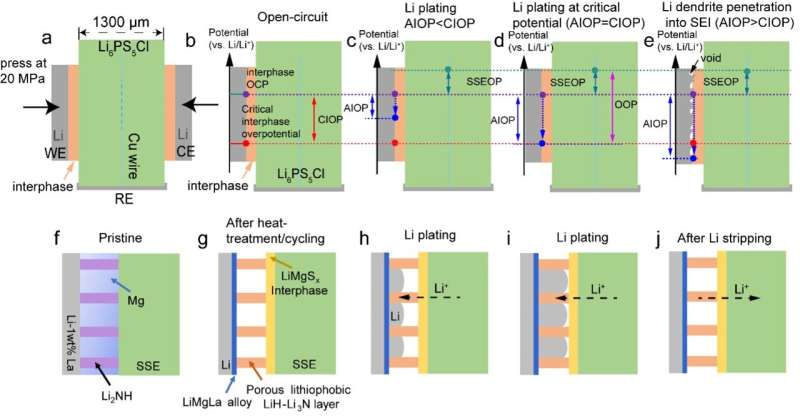April 6, 2023 feature
This article has been reviewed according to Science X's editorial process and policies. Editors have highlighted the following attributes while ensuring the content's credibility:
fact-checked
peer-reviewed publication
trusted source
proofread
Study defines a crucial parameter for the suppression of lithium dendrites in all-solid-state LiBs

All-solid-state lithium batteries (ASSLiBs), lithium batteries with solid electrolytes, are highly promising battery solutions, as they are often more stable than cells based on liquid electrolytes and have a higher capacity. However, the deposition of lithium inside these batteries can sometimes cause the formation of so-called lithium dendrites (i.e., crystals with treelike structures), which can lead to cell short circuits.
To assess the ability of ASSLiBs to suppress the formation of lithium dendrites, most battery developers currently measure their critical current density (CCD), a parameter that estimates the highest current density that the Li/Li symmetric cell can withstand before Li dendrites penetrate through the SSE and cause short circuiting. In a recent paper published in Nature Energy, however, a research group led by Chunsheng Wang, a Robert Franklin and Frances Riggs Wright Distinguished Chair in the Department of Chemical & Biomolecular Engineering (CHBE) and UMD Director of the Center for Research in Extreme Batteries at the University of Maryland, identified another parameter that could be better suited for evaluating the lithium dendrite suppression capabilities of ASSLiBs.
"We previously found that when decreasing the area specific resistance of a Li||Li cell, the CCD increased but the overpotential before the voltage drop did not notably change, which led us to think that it should be the overpotential, not CCD, that determines the Li-dendrite-suppression capability of solid-state electrolyte (SSEs)," Hongli Wan, one of the researchers who carried out the study, told Tech Xplore. "Because most SSEs are not stable to Li metal, solid-electrolyte interphase (SEI) will be formed at Li/SSE interface."
Wang and his colleagues found that when Li plating in ASSLiBs occurs at a low applied interphase overpotential (AIOP), the plated Li diffuses along the Li/SEI interface and maintains a planar growth. When the AIOP is higher than a critical interphase overpotential (CIOP), however, Li starts to penetrate the SEI, forming the undesirable dendrites.
"Upon further increase in the applied overpotential to increase the current density to the CCD, Li dendrites grow through the SSE, shorting the cell," Wan explained. "The CIOP is therefore the critical overpotential at which Li starts to penetrate the interphase."
Unlike the CCD, which varies according to the properties of the SSE integrated in a battery cell and other engineering parameters, the CIOP is an intrinsic property of SEIs. This key parameter is directly linked to the electrolyte's and interphase's lithiophobicity (i.e., its inherent ability to repel lithium) and mechanical properties.
This means that it could be a more reliable indicator of how well-suited a solid electrolyte is for designing high capacity ASSLiBs. In addition, it could guide the design of the interphase inside batteries, allowing researchers to compare the lithium dendrite suppression capabilities of different interphases.
"To achieve a Li-dendrite-free all-solid-state lithium-metal battery (ASSLB) with a high energy density, the SEI should have a high CIOP (and thus have high lithiophobicity and high mechanical strength) to suppress Li-dendrite penetration and a low AIOP (requiring a low SEI resistance and low interfacial resistance)," Wan said. "Our proposed mixed-conductive Li2NH–Mg interlayer can fulfill this requirement due to the in-situ formation of Li6PS5Cl/LiMgSx/Li3N-LiH/LiMgLa from Li6PS5Cl/Li2NH–Mg/Li–1.0 wt%La after annealing and cycling."
Using CIOP as a guiding parameter, Wang and his colleagues created an ASSLB design with a LiMgSx interphase that they expected would help to suppress the formation of lithium dendrites. They found that this interphase increased the CIOP from about 10 mV (in relation to the SEI of Li6PS5Cl) to about 220 mV, while the Li plates on the LiMgLa surface reversibly penetrated into porous LiH–Li3N, decreasing the AIOP.
The recent work by this team of researchers demonstrates the value of the CIOP parameter for assessing the ability of solid-state interphases to suppress the formation of lithium dendrites. In the future, the newly identified parameter could be used by other teams worldwide to design more desirable interphases for ASSLiBs and other solid-state metal batteries, potentially improving their performance and capacities.
"We proposed an interphase design criterion (AIOP/CIOP ˂ 1) that can enable the cell to achieve lithium-dendrite free," Wan added. "However, we have not yet fully addressed how to ensure that the AIOP does not surpass the CIOP. The AIOP is affected by the electronic and ionic conductivity of the interphase, Li diffusivity in the Li anode, and void formation at the Li/SSE interface. We are systematically investigating the impact of these factors on the AIOP."
More information: Hongli Wan et al, Critical interphase overpotential as a lithium dendrite-suppression criterion for all-solid-state lithium battery design, Nature Energy (2023). DOI: 10.1038/s41560-023-01231-w
© 2023 Science X Network


















